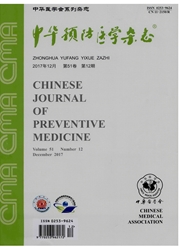

 中文摘要:
中文摘要:
目的探讨指端脉搏波分析技术检测动脉顺应性的可行性。方法2004年9至10月,采用整群抽样方法,抽取415例成人(农村195人、城市220人,男132人、女283人),平均年龄(47.23±13.85)岁,用Pulsetraee指端脉搏波测量仪测定动脉硬化指数,重复测量3次,取平均值。结果每例样本的3次硬化指数检测波动范围在4.65%以内(s=0.050),重复检测结果的相关系数达到0.937,与大动脉脉搏波传导速度的相关性为0.629。城乡、男女之间硬化指数的差异见统计学意义。硬化指数与收缩压和年龄的相关性最好,二者的决定系数达到0.613。20~29岁、30—39岁、40~49岁、50~59岁和≥60岁组的硬化指数均值分别为7.35、8.84、10.41、10.95和12.01m/s,组间差异有统计学意义。结论收缩压和年龄是动脉顺应性的主要影响因素。指端脉搏波分析技术在流行病学研究中具有较好的可行性和推广使用价值。
 英文摘要:
英文摘要:
Objective To explore the reliability and validity of digital pulse wave analyzing method in evaluating arterial compliance in population-based study. Methods All 415 adults ( 132 men and 283 women) aged 20 to 86 years old were selected from urban (220 persons) and rural ( 195 persons) areas, respectively by a stratified randomly sampling method. Arterial compliance, evaluated by stiffness index ( SI), was measured by using digital pulse wave analyzing method from the Pulse trace machine ( Micro medical, London ), and the SI value was determined accordingly. Results In the study on both repeatability and stability, there was a perfect correlation between the frequent measurements for one individual either on one occasion or on two 40-days-apart occasions. The SI values were not significantly different between the urban and the rural, men and women. Multiple stepwise regressions showed that systolic blood pressure and age were positively correlated with SI value, respectively ( both P values were less than 0. 001 ). The correlation kept unchanged after taking account of gender, BMI and heart rate. The mean SI values for people aged 20 to 29, 30 to 39, 40 to 49, 50 to 59 and ≥60 were 7.35, 8.84, 10. 41, 10. 95 and 12. 01 m/s(P 〈 0. 01 ), respectively. Conclusions Both systolic blood pressure and age should be contributed as the main influencing factors of arterial compliance. Digital pulse wave analyzing method is a preferable measurement in evaluating arterial compliance in population-based study due to its better repeatability and stability.
 同期刊论文项目
同期刊论文项目
 同项目期刊论文
同项目期刊论文
 期刊信息
期刊信息
